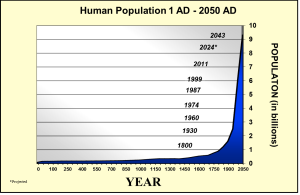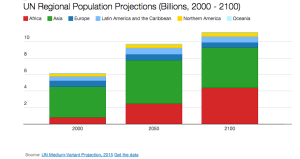The human population of Earth has expanded at a staggering rate and is continuing to grow, providing challenges that need to be solved in the very near future. By Domi, Tellus Think Tank 2016-02-01
Earth’s population reached 7.3 billion in 2015 and 100’s of millions of people go to bed hungry due to, currently not the lack of food on Earth but, higher food prices than can be afforded.
The population of Earth continues to grow and the United Nations forecasts that by the year 2050 the population of Earth will be 10 billion.

A combination of several challenges will make it harder to grow the crops necessary to boost food production to feed the growing population. To mention some of the challenges we are facing:
- Global Warming and climate change bringing extreme weather, read more…
- An increasing fresh water scarcity around the planet
- The continued erosion of farmland soil
- Growing human population of Earth
The UN expects several consequences of strains in food and water supply such famine, a continued increase in the number of refugees and the risk for even more conflict and civil war around the world.
It all raises questions about the future of humanity and life on our planet and the importance of feeding our population, will we be able to feed 10 billion people?

There IS hope! One development is the Plantagon Vertical Skyscraper, aiming to feed cities of the future, read more here. Tellus Think Tank will be adding even more hope and inspiration soon!
More on the growth of the human population on Earth
Tariq Khokhar and Haruna Kashiwase, both working for the World Bank, gathered four trends from the UN’s update on population projections:
Tariq and Haruna discuss how accurate the 2015 UN projections might become and show that looking back at UN projections from 1958 they turned out to be “pretty good”, differing from what actually happened with only less than 5%.
Here is a description of the trends, identified by Haruna and Tariq, based on the UN predictions for world population growth of 2015.
- The world’s population is estimated to reach 11.2 billion inhabitants in year 2100.
The population of Earth is currently, January 2016, about 7.3 billion.
UN projections show that growth will slow down a bit but still predict to reach 9.7 billion inhabitants by 2050 and 11.2 billion inhabitants by the year of 2100. - In the year 2100 more than 80% of Earth’s inhabitants will live in Africa or Asia.
Currently about 66% of the world’s population lives in Asia but in 2100 forecasts show that Africa and Asia will be the home of 83% of the world’s population.

The United Nations predict of 2015 show that the populations of Africa and Asia are growing faster than other continents. - Africa will be the fastest growing region between 2015 and 2050.
In number of inhabitants Africa will be the largest contributor to the increase of the world population. Europe was projected to have a shrinking population. - Half of the world’s population growth will occur in just 9 countries during 2015 and 2050.
The nine countries are:
India with 16.6% of the total growth – 394 million people
Nigeria with 9.11% of the total growth – 216 million people
Pakistan with 5.08% of the total growth – 121 million people
Democratic Republic of the Congo with 4.97% of the total growth – 118 million people
Ethiopia with 3.75% of the total growth – 89 million people
United States of America with 2.82% of the total growth – 67 million people
Indonesia with 2.72% of the total growth – 65 million people
Uganda with 2.65% of the total growth – 63 million people
According to the UN projections show that by 2022 India will have more inhabitants than China. The United States sticks out as the only high-income country on the list due to projections of continued migration, all other countries on the list are to be found either in Africa or Asia.
There are a lot of good things happening to mitigate the rising challenges of the population growth.
It is the aim of Tellus Think Tank to share ideas and solutions for improving sustainability in lives and communities.
Get inspired and learn more about how the challenges of Earth can be tackled.






